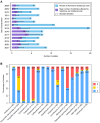Clinical Presentation, Antimicrobial Resistance, and Treatment Outcomes of Aeromonas Human Infections: A 14-Year Retrospective Study and Comparative Genomics of 2 Isolates From Fatal Cases
- PMID: 38759099
- PMCID: PMC11581697
- DOI: 10.1093/cid/ciae272
Clinical Presentation, Antimicrobial Resistance, and Treatment Outcomes of Aeromonas Human Infections: A 14-Year Retrospective Study and Comparative Genomics of 2 Isolates From Fatal Cases
Abstract
Background: Aeromonas virulence may not be entirely dependent on the host's immune status. Pathophysiologic determinants of disease progression and severity remain unclear.
Methods: One hundred five patients with Aeromonas infections and 112 isolates were identified, their clinical presentations and outcomes were analyzed, and their antimicrobial resistance (AMR) patterns were assessed. Two isolates (A and B) from fatal cases of Aeromonas dhakensis bacteremia were characterized using whole-genome sequencing. Virulence factor- and AMR-encoding genes from these isolates were compared with a well-characterized diarrheal isolate A. dhakensis SSU and environmental isolate Aeromonas hydrophila American Type Culture Collection_7966T.
Results: Skin and soft tissue infections, traumatic wound infections, sepsis, burns, and intraabdominal infections were common. Diabetes, malignancy, and cirrhosis were frequent comorbidities. Male sex, age ≥ 65 years, hospitalization, burns, and intensive care admission were associated with complicated disease. High rates of AMR to carbapenems and piperacillin-tazobactam were found. Treatment failure was observed in 25.7% of cases. Septic shock and hospital-acquired infections were predictors of treatment failure. All 4 isolates harbored assorted broad-spectrum AMR genes including blaOXA, ampC, cphA, and efflux pumps. Only clinical isolates possessed both polar and lateral flagellar genes, genes for various surface adhesion proteins, type 3 and 6 secretion systems and their effectors, and toxin genes, including exotoxin A. Both isolates A and B were resistant to colistin and harbored the mobile colistin resistance-3 (mcr-3) gene.
Conclusions: Empirical therapy tailored to local antibiograms may facilitate favorable outcomes, while advanced diagnostic methods may aid in identifying correct Aeromonas spp. of significant clinical importance.
Keywords: Aeromonas; antimicrobial resistance; genomics; retrospective study.
© The Author(s) 2024. Published by Oxford University Press on behalf of Infectious Diseases Society of America. All rights reserved. For commercial re-use, please contact reprints@oup.com for reprints and translation rights for reprints. All other permissions can be obtained through our RightsLink service via the Permissions link on the article page on our site—for further information please contact journals.permissions@oup.com.
Conflict of interest statement
Potential conflicts of interest. The authors: No reported conflicts of interest. All authors have submitted the ICMJE Form for Disclosure of Potential Conflicts of Interest. Conflicts that the editors consider relevant to the content of the manuscript have been disclosed.
Figures

References
-
- Clark NM, Chenoweth CE. Aeromonas infection of the hepatobiliary system: report of 15 cases and review of the literature. Clin Infect Dis 2003; 37:506–13. - PubMed
Publication types
MeSH terms
Substances
Supplementary concepts
Grants and funding
LinkOut - more resources
Full Text Sources
Medical
Miscellaneous

